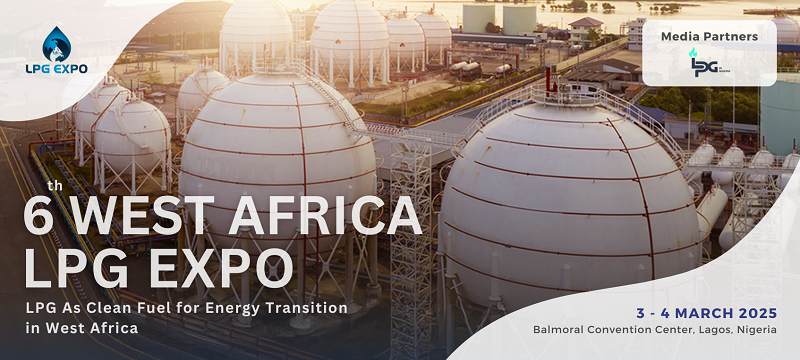- 5565
- 0
Sharing Ideas and Updates on LPG in Nigeria and related information to enable effective collaboration within the LPG Value Chain
BENEFITS OF UNDERGROUND LPG TANK INSTALLATION IN 2024

LPG (Liquefied Petroleum Gas) serves as a versatile and efficient energy source, finding extensive use in residential, commercial, and industrial settings worldwide. As the demand for clean and sustainable energy grows, the installation of LPG tanks becomes a pivotal consideration. Among the various installation options, underground LPG tanks have emerged as a popular choice owing to their numerous advantages.
Underground LPG tank installations offer a range of benefits that encompass safety, aesthetics, space utilization, and environmental considerations. Let's delve into the advantages that make underground tanks a compelling choice for businesses and homeowners seeking an efficient and secure LPG storage solution.
Installing LPG underground tanks offers several benefits that contribute to enhanced safety, aesthetics, and space utilization:
Safety and Aesthetics: Underground tanks are secure and out of sight, reducing the risk of accidental damage or vandalism. This enhances overall safety, especially in residential areas, while maintaining a visually pleasing environment without visible tanks.
Space Optimization: Underground tanks efficiently utilize space by freeing up the surface area for other purposes like landscaping or parking. This is particularly advantageous in urban areas or locations with limited space.
Environmental Friendliness: Underground LPG tanks have minimal impact on the surrounding environment. They reduce visual clutter, preserve green spaces, and don’t obstruct the landscape.
Protection from Elements: Buried underground, these tanks are shielded from weather elements, minimizing exposure to extreme temperatures and weather conditions, which can extend their lifespan.
Property Value: Installing underground LPG tanks can potentially enhance property values, as they contribute to a clean and uncluttered appearance, appealing to potential buyers or tenants.
Regulatory Compliance: In some areas, underground installation might align with specific regulations or zoning requirements, making it a preferable option for compliance purposes.
Reduced Vandalism or Theft: By being concealed underground, these tanks are less susceptible to vandalism or theft compared to above-ground alternatives.
Remember, while underground tanks offer various advantages, their installation involves specialised processes, excavation, and compliance with safety regulations. It's crucial to consult with professionals and adhere to local regulations to ensure a safe and compliant installation.
Here are some guidelines from NMDPRA on the installation and refilling of above-ground and underground tanks.
Site Selection Criteria:
The site must provide ample space to minimize risks from LPG to nearby structures and individuals.
Requirements include roadside accessibility, avoidance of known hazards, a minimum 100-meter radius from existing LPG plants, and specific distances from property lines.
Drainage should not channel to waterways; contaminated water must be contained and treated on-site.
Facility Layout:
Emphasises proper hazard classification and risk assessment for safe facility design and operation.
Highlights the need for strategic placement of tanks, pipes, and infrastructure to ensure escape routes, prevent ignition sources, and facilitate safe access and parking.
LPG Storage Vessel Specification and Requirements:
Tanks must be designed, constructed, and installed by accredited companies, complying with international standards.
Proper positioning, materials, safety equipment, pressure relief valves, gauges, and temperature sensors are mandatory.
Overpressure protection, water sprinkler systems, and accessibility for inspection and maintenance are essential.
Underground LPG Tank Burial and Leak Test:
Tanks require NMDPRA approval for burial, adherence to manufacturer and international codes, and specific pit dimensions.
Tanks should be set in waterproof concrete with protective measures against damage, corrosion, and electrical connections.
Installation must prevent soil contamination and support tanks to prevent movement or settlement.
Corrosion Protection for Buried Tanks:
Cathodic protection and surface coating guidelines are specified to prevent chemical and mechanical damage.
Requirements for Skid, Modularized, and Containerized Facilities:
Must adhere to safety distances and additional safety measures for adequate ventilation, detectors, and firefighting equipment.
Technical specifications must be provided to DPR for consistency and approval for any site layout changes or modifications.
These guidelines ensure proper site selection, safe facility layout, stringent tank specifications, burial procedures, corrosion protection, and safety measures for specialised facilities, while maintaining safety standards and regulatory compliance.
LPG in Nigeria, through our partners, offers the sale of underground LPG sales and installations. Click here to explore the many options available to you and contact us for further information.















0 Comment.